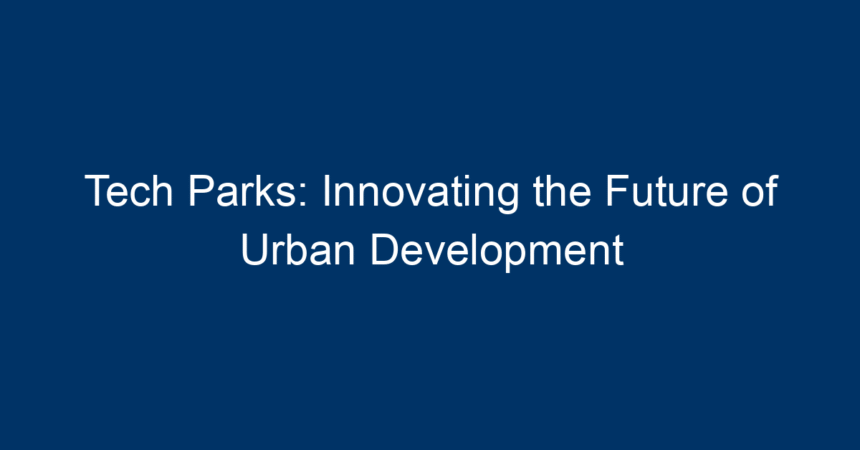In today’s rapidly evolving urban landscape, tech parks are carving out a niche as epicenters of innovation, productivity, and economic growth. These specialized hubs not only promote technology-driven business ventures but also foster collaboration between start-ups, established companies, and academic institutions. As cities around the world strive to adapt to the challenges of the ever-changing technological environment, tech parks are emerging as vital players in urban development. This article delves into the multifaceted role that tech parks play in shaping the future of urban landscapes, as well as the significant benefits they bring to communities.
What Are Tech Parks?
At their core, tech parks—also known as technology parks or innovation centers—are designated areas aimed at fostering technological advancement and entrepreneurship. They typically house offices, laboratories, and facilities that support high-tech industries such as information technology, biotechnology, and engineering. By clustering innovative firms together, these parks create an ecosystem conducive to collaboration, knowledge sharing, and creativity.
Evolution of Tech Parks
The concept of tech parks gained traction in the late 20th century, largely in response to the growing need for technological innovation. Notable examples include Silicon Valley in California and the Cambridge Science Park in the UK. Over the years, the role of tech parks has evolved; they now often include residential spaces, retail shops, and recreational areas, making them vibrant mini-cities within urban settings.
Benefits of Tech Parks
The advantages of tech parks extend beyond mere economic metrics. They bring a multitude of benefits that can revitalize local economies and enhance community development.
1. Economic Growth
By attracting high-tech companies and skilled professionals, tech parks stimulate local economies. They create jobs, both directly within the parks and indirectly in surrounding businesses that cater to the needs of the tech workforce.
2. Innovation and Collaboration
Collaboration is at the heart of tech parks. When innovative companies are in close proximity, the exchange of ideas flourishes. Incubators and accelerators within these parks provide resources and mentorship to start-ups, helping them transition from ideas to viable businesses.
3. Educational Partnerships
Many tech parks have established partnerships with local universities and research institutions. This symbiotic relationship allows for the translation of academic research into practical applications. Students gain hands-on experience, while companies benefit from fresh ideas and talent.
4. Sustainable Urban Development
Modern tech parks often prioritize sustainability and smart design. Features such as green buildings, renewable energy sources, and accessible public transport systems make these parks models for future urban development.
Key Components of Successful Tech Parks
To ensure their success, several key components need to be prioritized in the development of tech parks:
1. Infrastructure
Robust infrastructure is fundamental. High-speed internet, transportation, and proximity to airports play a pivotal role in attracting businesses. A well-planned tech park incorporates flexible workspace options and state-of-the-art facilities.
2. Support Services
Beyond physical space, successful tech parks offer a range of support services, including legal, financial, and marketing assistance. Access to venture capital and networking opportunities can significantly enhance the growth potential of companies within the park.
3. Community Engagement
Involving the local community is crucial for the sustainability of tech parks. Hosting events, workshops, and open houses fosters inclusivity and ensures that the park meets the needs of residents and businesses alike.
Case Studies: Successful Tech Parks Around the World
1. Silicon Valley, California
Silicon Valley is arguably the most famous tech park globally, serving as the home to giants like Google and Facebook. Its unique blend of venture capital, skilled workforce, and educational institutions have positioned it as a leader in innovation. The interplay between cultural diversity and technological advancement has birthed countless start-ups and revolutionary ideas.
2. Shenzhen, China
Shenzhen has transformed from a small fishing village into a tech powerhouse in just a few decades. The city boasts over 60 tech parks, creating a dynamic ecosystem for start-ups and established firms alike. Initiatives by the local government provide funding and support, making Shenzhen a great case study for emerging tech hubs.
3. Cambridge Science Park, UK
The Cambridge Science Park has been instrumental in fostering biotechnology and life sciences. With its proximity to the University of Cambridge, it serves as a breeding ground for innovation and research commercialization. It exemplifies how academic and business partnerships can drive technological advancements.
The Role of Government in Tech Park Development
The establishment and growth of tech parks often require government intervention and support. Public policies that promote research and development, tax incentives for tech companies, and funding for infrastructure projects play critical roles in the success of these technological hubs. Governments must create a conducive ecosystem that encourages private investment while ensuring community needs are met.
Challenges Facing Tech Parks
Despite their numerous benefits, tech parks are not without challenges.
1. Market Saturation
As more tech parks are established, the market may become saturated, leading to competition for businesses and talent. This can dilute the unique value proposition that individual parks offer.
2. Balancing Growth and Sustainability
Rapid growth can strain resources, including housing, transportation, and community services. Tech parks must find ways to balance expansion with the need for sustainable practices.
3. Evolving Technologies
The pace of technological change can render some businesses obsolete. Tech parks must remain adaptable and continuously innovate to stay relevant and attract new tenants.
Future Trends in Tech Parks
As we look ahead, several trends are likely to shape the future of tech parks:
1. Integration of Smart Technologies
The rise of IoT (Internet of Things) and AI (Artificial Intelligence) will enhance the functionality of tech parks. Smart buildings equipped with technological amenities will improve efficiency and user experience.
2. Emphasis on Remote Work
The COVID-19 pandemic has shifted attitudes toward remote work. Tech parks may adapt by offering flexible space solutions that accommodate both remote and traditional work models.
3. Focus on Inclusivity
As tech parks evolve, there is an increasing emphasis on inclusivity and diversity. Parks will need to attract a broad range of businesses and professionals from varied backgrounds to stimulate innovation.
Conclusion: The Way Forward for Tech Parks
Tech parks are more than just clusters of businesses; they are communities driving the future of urban development. By prioritizing collaboration, sustainability, and community engagement, these parks can create ecosystems that not only boost local economies but also enhance quality of life.
For entrepreneurs, developers, and policymakers, leveraging the potential of tech parks presents a unique opportunity to innovate and grow. As we navigate the complexities of modern urban life, embracing the power of technology in our cities will be crucial for a sustainable and prosperous future.
Actionable Insights:
- Research Local Opportunities: If you’re an entrepreneur, explore tech parks in your area for resources, networking, and support.
- Engage with Community: Community involvement is vital; attend public meetings and events hosted by tech parks.
- Consider Sustainability: If you’re developing a tech park, prioritize green infrastructure and sustainable practices.
- Stay Adaptable: Businesses in tech parks must continuously innovate and adapt to changing technologies to remain competitive.
As cities embrace tech parks, they pave the way toward a future where urban development and technological advancement go hand in hand. The journey is just beginning, and the potential is boundless.




